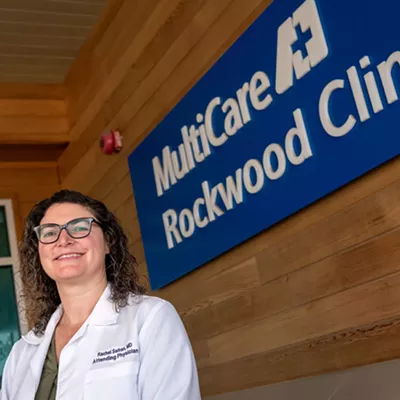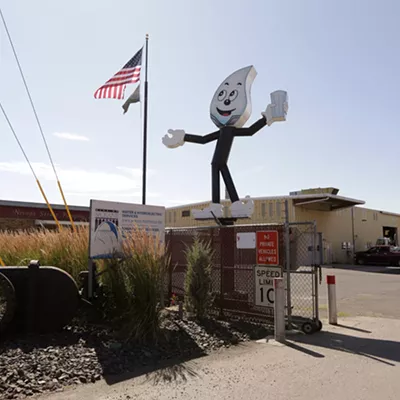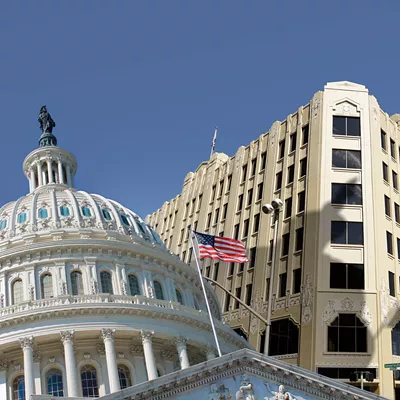A time-lapse video of the last few decades, fixed on the 78 barren acres in the middle of Spokane now known as Kendall Yards, would have shown basically the same, nearly unchanging image:
Dirt and railroad rubble. The final frames of the video, however, would have captured a flurry of home-building, street paving and moving trucks.
In the last year, Greenstone Homes has done what its predecessors, Metropolitan Mortgage and Marshall Chesrown, never could do with the property, building 60 new units, 35 of which have already sold.
In 2007, the City of Spokane and Kendall Yards — then under the ownership of Chesrown’s Black Rock Development — signed an agreement in which the developer would build Kendall Yards’ roads, sewer lines and water mains, and the city would partly pay them back.
The agreement, however, required that all subcontractors be chosen through an open public bidding process. So far, Greenstone has spent $5 million on infrastructure — none of it through public bidding. For four months, city staffers worked to revise the agreement so that Greenstone could be paid despite this. But earlier this month, the city council rejected Greenstone’s request for retroactive compensation.
Now, as Greenstone continues construction, the city is working to find a way to both continue its long-standing support of the urban project and try to make sure such snafus don’t happen again — as well as plan for future public-private financial arrangements.
In your typical housing development, the private developer pays for streets, sidewalks, sewers and other infrastructure. When they’re done, they deed the infrastructure over to the city.
But when the city provides the financing, Washington state law usually requires that projects be subject to public bidding. Eligible contractors submit sealed bids, and then the developer chooses the best deal.
Public bidding requirements, Spokane City Engineer Mike Taylor explains, evolved out of an effort to dismantle “good ol’ boy” networks. By preventing elected officials from awarding contracts to their buddies — or campaign contributors — and cutting down on graft, everyone was given a fair shot at the project. Over time, requirements for public bidding were fleshed out, adding stipulations for fair wages and safety measures.
“It avoids corruption, it ensures quality,” Taylor says. But Greenstone had reason not to use public bidding. “In their case, they have a complete team from cradle to grave,” Taylor says. “They work with contractors they’re comfortable with.”
More problematically for Greenstone, the public bidding process takes a lot of time. For public bidding to design a road, Greenstone would have had to make a request for qualifications, then review those qualifications, then decide who to reward it to, then wait for the architect to design it, then wait for city staff to approve it — then the entire process would repeat to choose the firm to actually construct it.
“There’d be nothing on the ground today,” says Jim Frank, CEO and founder of Greenstone. “We’d still be involved in the public bidding process.”
The current construction of Kendall Yards’ Summit Boulevard took Greenstone six months. Using public bidding, Frank says, that time would have tripled.
“Typically, a
government project would add on approximately 30 percent to the cost to
any project,” says Gavin Cooley, Spokane’s chief financial officer.
That’s one reason why the city likes to purchase already-built buildings
— such as its new evidence facility — instead of building them.
Few private developments are subject to public bidding requirements. But to spur development downtown, the city made Kendall Yards a Tax Increment Financing (TIF) district in 2007, 2 1/2 years before Greenstone bought it.
Chesrown’s reimbursement agreement for Kendall Yards in 2007 guaranteed the city would reimburse his company for some of the infrastructure it constructed (using some of the extra tax revenue such a project would generate). But the nature of the public-private agreement required it to hew to public works laws — including public bidding.
According to Frank, he and his team didn’t know that was part of the deal. He says Greenstone didn’t actually review the TIF agreement until the fall of 2010 — months after they’d purchased Kendall Yards and begun the first phase of construction.
Frank is unapologetic.
Even after they saw it, he says, Greenstone continued building its homes in Kendall Yards because construction — not reimbursement — was the priority. He says he needed to prove that he could make Kendall Yards happen, unlike its previous two owners.
“Kendall Yards sat empty too long,” Frank says. “You’ve seen the golden shovels and the fancy announcements. We needed to move quickly to put product on the ground. Who’s going to buy something they don’t know is going to be finished?”
Frank had worked under TIFs before — River District in Spokane County, Center Point and West Seltice in Post Falls — but the public bidding question was never an issue. There, Greenstone had a way to escape any public bidding requirements: build the improvements with the understanding that the developments might be eligible for TIF money, but no guarantees. That way, it doesn’t technically become financed with public money — subject to public bidding laws — until after it’s completed.
Last month, Greenstone and city staffers brought the city council a proposal that would do just that, allowing Greenstone to eventually receive the TIF money for current construction.
But with the exception of Councilwoman Nancy McLaughlin, the council voted to table the proposal indefinitely. The retroactive nature of the proposal and the lack of prior notification from Greenstone were key sticking points.
“Maybe we could have come to some sort of understanding … if the council had been engaged earlier,” says Councilwoman Amber Waldref. “They were working on this for four months.”
Delaying construction for four months while an agreement was figured out, Frank says, would have been too long. “If we had waited to get this all sorted out, we would have had to delay all of our construction — we weren’t prepared to do that,” Frank says.
In the end, Greenstone decided to forgo compensation for what had already been constructed.
“Like I say, at the end of the day, we had no regrets,” Frank says. “The reimbursement of this $1 million is less important than the success of this project.”
In the coming months, says city spokeswoman Marlene Feist, city staffers and Greenstone will work on two proposals. The first will clarify, once and for all, if Greenstone could qualify for Kendall Yard’s TIF money in the future without public bidding.
“We want to get it resolved before too much more water goes under the bridge,” Frank says. The mayor, Feist says, wants this to be figured out before Greenstone starts its second phase of construction at Kendall Yards.
The second proposal will be a new city policy for handling TIFs — and other financing methods — in the future.
“The
point of the TIF is economic development,” Waldref says. “If we’re
making it hard to develop through the incentive, it’s not working. It’s
broken.”























